Leadership Approaches in Healthcare: A Transformational Report
VerifiedAdded on 2020/07/23
|12
|2761
|194
Report
AI Summary
This report delves into the transformational leadership approach within the healthcare sector, specifically focusing on its application in nursing. It begins by identifying transformational leadership as a key approach and outlines its core features, including inspirational motivation, idealized influence, individual consideration, and intellectual stimulation. The report provides real-world examples, such as senior nurses mentoring junior staff, to illustrate how these features manifest in practice. It then reflects on the assumptions regarding the roles of healthcare professionals, patients, and carers under this approach, emphasizing the importance of motivation, positive change, and high-quality care. The contribution of transformational leadership to quality healthcare is discussed, highlighting the development of skills among nursing staff and colleagues. Finally, the report explores opportunities for graduate nurses to develop leadership skills and concludes with a personal reflection on the author's aspirations to become a pediatric nurse, outlining essential skills and knowledge required for this role, such as effective communication, critical thinking, and knowledge of pediatric health.
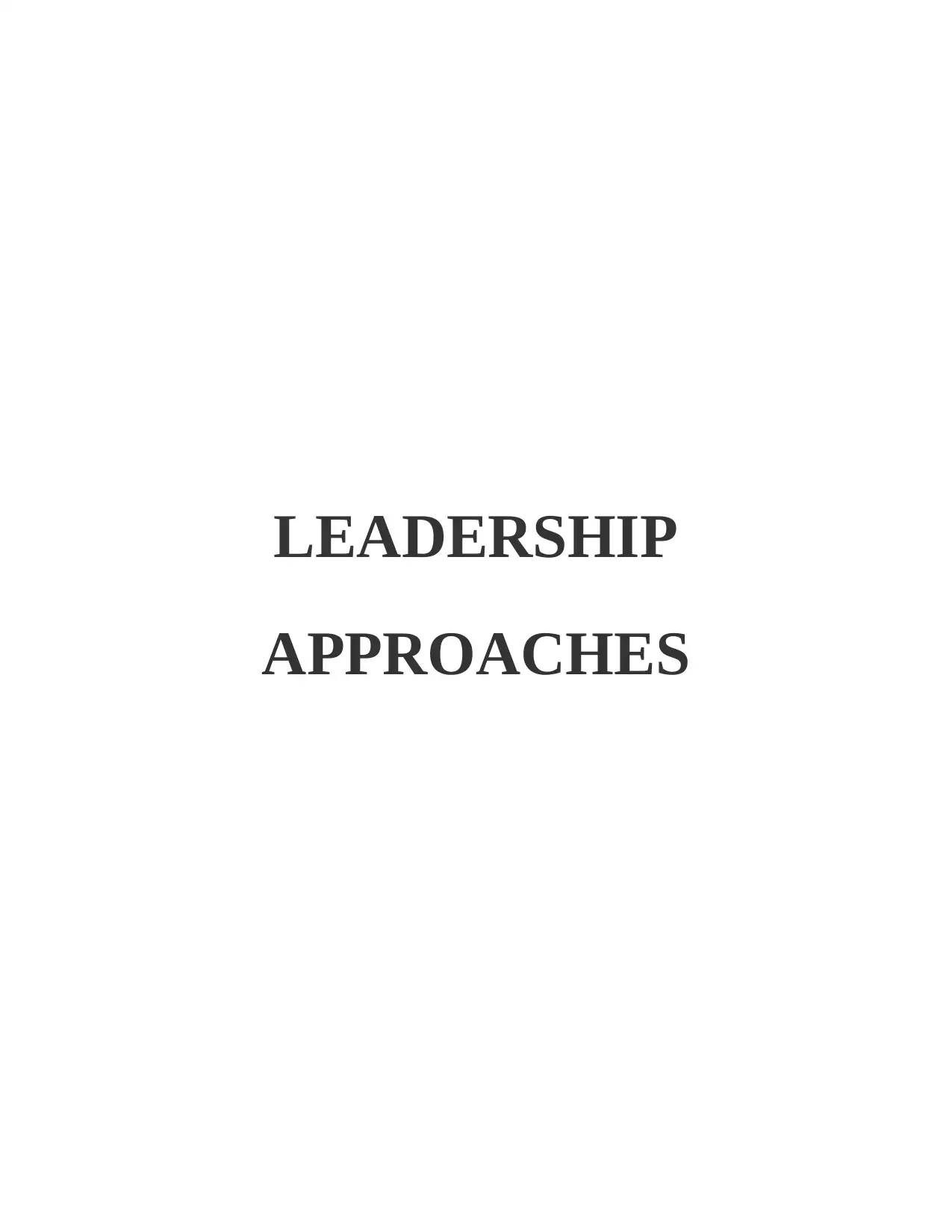
LEADERSHIP
APPROACHES
APPROACHES
Paraphrase This Document
Need a fresh take? Get an instant paraphrase of this document with our AI Paraphraser
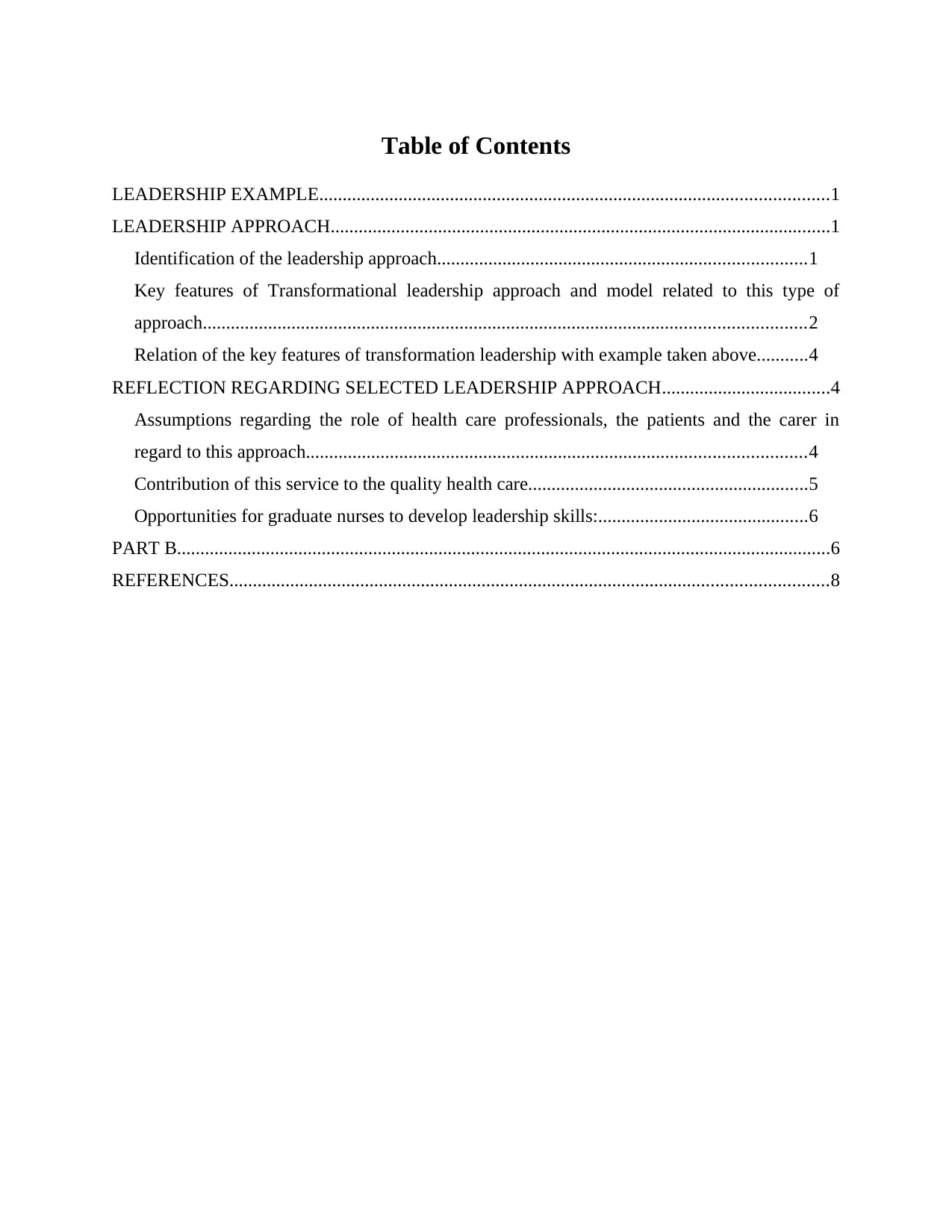
Table of Contents
LEADERSHIP EXAMPLE.............................................................................................................1
LEADERSHIP APPROACH...........................................................................................................1
Identification of the leadership approach...............................................................................1
Key features of Transformational leadership approach and model related to this type of
approach.................................................................................................................................2
Relation of the key features of transformation leadership with example taken above...........4
REFLECTION REGARDING SELECTED LEADERSHIP APPROACH....................................4
Assumptions regarding the role of health care professionals, the patients and the carer in
regard to this approach...........................................................................................................4
Contribution of this service to the quality health care............................................................5
Opportunities for graduate nurses to develop leadership skills:.............................................6
PART B............................................................................................................................................6
REFERENCES................................................................................................................................8
LEADERSHIP EXAMPLE.............................................................................................................1
LEADERSHIP APPROACH...........................................................................................................1
Identification of the leadership approach...............................................................................1
Key features of Transformational leadership approach and model related to this type of
approach.................................................................................................................................2
Relation of the key features of transformation leadership with example taken above...........4
REFLECTION REGARDING SELECTED LEADERSHIP APPROACH....................................4
Assumptions regarding the role of health care professionals, the patients and the carer in
regard to this approach...........................................................................................................4
Contribution of this service to the quality health care............................................................5
Opportunities for graduate nurses to develop leadership skills:.............................................6
PART B............................................................................................................................................6
REFERENCES................................................................................................................................8

Illustration Index
Illustration 1: Transformational leadership "Four I's" Modal..........................................................2
Illustration 1: Transformational leadership "Four I's" Modal..........................................................2
⊘ This is a preview!⊘
Do you want full access?
Subscribe today to unlock all pages.

Trusted by 1+ million students worldwide

LEADERSHIP EXAMPLE
At all level in the nursing profession leadership is the key skill of nurses. According to
Romano, Trotta and Rich, (2013) leadership includes the process that helps in encouraging the
followers to achieve the set goals. For example, senior’s nurses are able to evolve other nursing
staff maturely by encouraging them and to learn and practice new skills in safe environment.
This helps in developing the advanced nursing techniques in all other nurses. Thus, here the
process of leadership was mixed with development activities in group to achieve the defined
aims and helps in the development of the whole nursing staff.
Leaders in the nursing profession generally refers to persons working as nurse managers
and executive nurses. Still, there is no exact definition of the leadership but generally it is taken
as approach that helps in influencing people to move together for achieving a single goal. As per
the views of Parris and Peachey (2013) along with this nurses play many other leadership roles
for example, facilitating many development programmes for staff members of organisation that
helps in lowering down the stress, sickness and burnout among fellow workers and develop new
ideas to lower down the condition leading to stress. It is a global belief that a successful leader
will look for every person and recognise their skills and tends to fulfil their needs in the working
place.
LEADERSHIP APPROACH
Identification of the leadership approach.
There are several types of leadership approaches and each have its own criteria of
influencing the followers. Different type of leaderships is: transformational leadership,
authoritarian leadership, servant leadership, Laissez-faire leadership and democratic leadership.
The appropriate approach that is selected for this literature is transformational leadership
approach. James MacGregor Burns is the person who coined this term of transformational
leadership in 1978 in order to describe ideal situation that arises between leaders and their
respective followers. This leadership style is related to changes that take place in individual and
its surrounding social system.
According to Omar (2013), transformational leadership is a unique approach in which
leaders and their followers work together in order to raise each other at higher level of their
ethics and morality. Transformational leadership tends to create a positive and valuable
1
At all level in the nursing profession leadership is the key skill of nurses. According to
Romano, Trotta and Rich, (2013) leadership includes the process that helps in encouraging the
followers to achieve the set goals. For example, senior’s nurses are able to evolve other nursing
staff maturely by encouraging them and to learn and practice new skills in safe environment.
This helps in developing the advanced nursing techniques in all other nurses. Thus, here the
process of leadership was mixed with development activities in group to achieve the defined
aims and helps in the development of the whole nursing staff.
Leaders in the nursing profession generally refers to persons working as nurse managers
and executive nurses. Still, there is no exact definition of the leadership but generally it is taken
as approach that helps in influencing people to move together for achieving a single goal. As per
the views of Parris and Peachey (2013) along with this nurses play many other leadership roles
for example, facilitating many development programmes for staff members of organisation that
helps in lowering down the stress, sickness and burnout among fellow workers and develop new
ideas to lower down the condition leading to stress. It is a global belief that a successful leader
will look for every person and recognise their skills and tends to fulfil their needs in the working
place.
LEADERSHIP APPROACH
Identification of the leadership approach.
There are several types of leadership approaches and each have its own criteria of
influencing the followers. Different type of leaderships is: transformational leadership,
authoritarian leadership, servant leadership, Laissez-faire leadership and democratic leadership.
The appropriate approach that is selected for this literature is transformational leadership
approach. James MacGregor Burns is the person who coined this term of transformational
leadership in 1978 in order to describe ideal situation that arises between leaders and their
respective followers. This leadership style is related to changes that take place in individual and
its surrounding social system.
According to Omar (2013), transformational leadership is a unique approach in which
leaders and their followers work together in order to raise each other at higher level of their
ethics and morality. Transformational leadership tends to create a positive and valuable
1
Paraphrase This Document
Need a fresh take? Get an instant paraphrase of this document with our AI Paraphraser
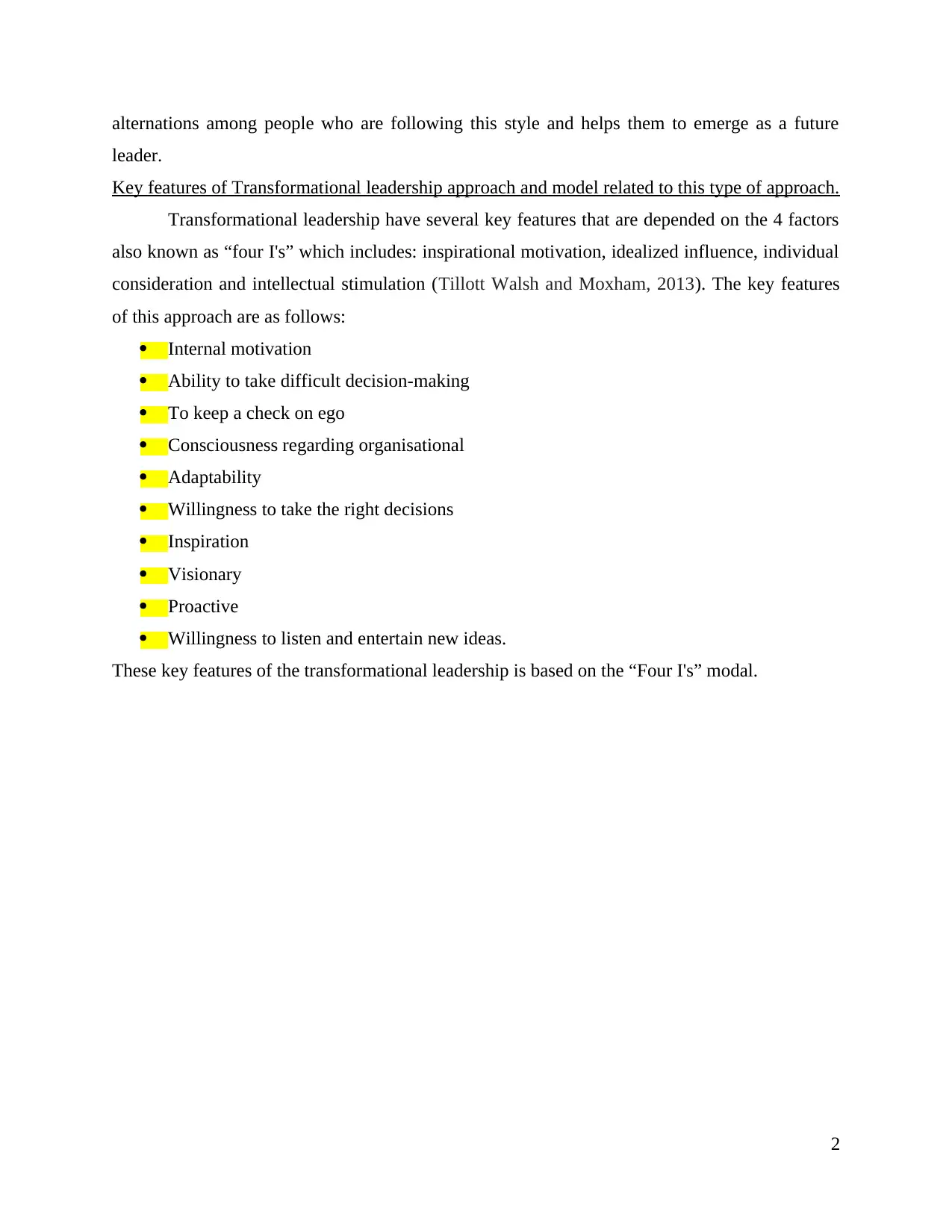
alternations among people who are following this style and helps them to emerge as a future
leader.
Key features of Transformational leadership approach and model related to this type of approach.
Transformational leadership have several key features that are depended on the 4 factors
also known as “four I's” which includes: inspirational motivation, idealized influence, individual
consideration and intellectual stimulation (Tillott Walsh and Moxham, 2013). The key features
of this approach are as follows:
Internal motivation
Ability to take difficult decision-making
To keep a check on ego
Consciousness regarding organisational
Adaptability
Willingness to take the right decisions
Inspiration
Visionary
Proactive
Willingness to listen and entertain new ideas.
These key features of the transformational leadership is based on the “Four I's” modal.
2
leader.
Key features of Transformational leadership approach and model related to this type of approach.
Transformational leadership have several key features that are depended on the 4 factors
also known as “four I's” which includes: inspirational motivation, idealized influence, individual
consideration and intellectual stimulation (Tillott Walsh and Moxham, 2013). The key features
of this approach are as follows:
Internal motivation
Ability to take difficult decision-making
To keep a check on ego
Consciousness regarding organisational
Adaptability
Willingness to take the right decisions
Inspiration
Visionary
Proactive
Willingness to listen and entertain new ideas.
These key features of the transformational leadership is based on the “Four I's” modal.
2
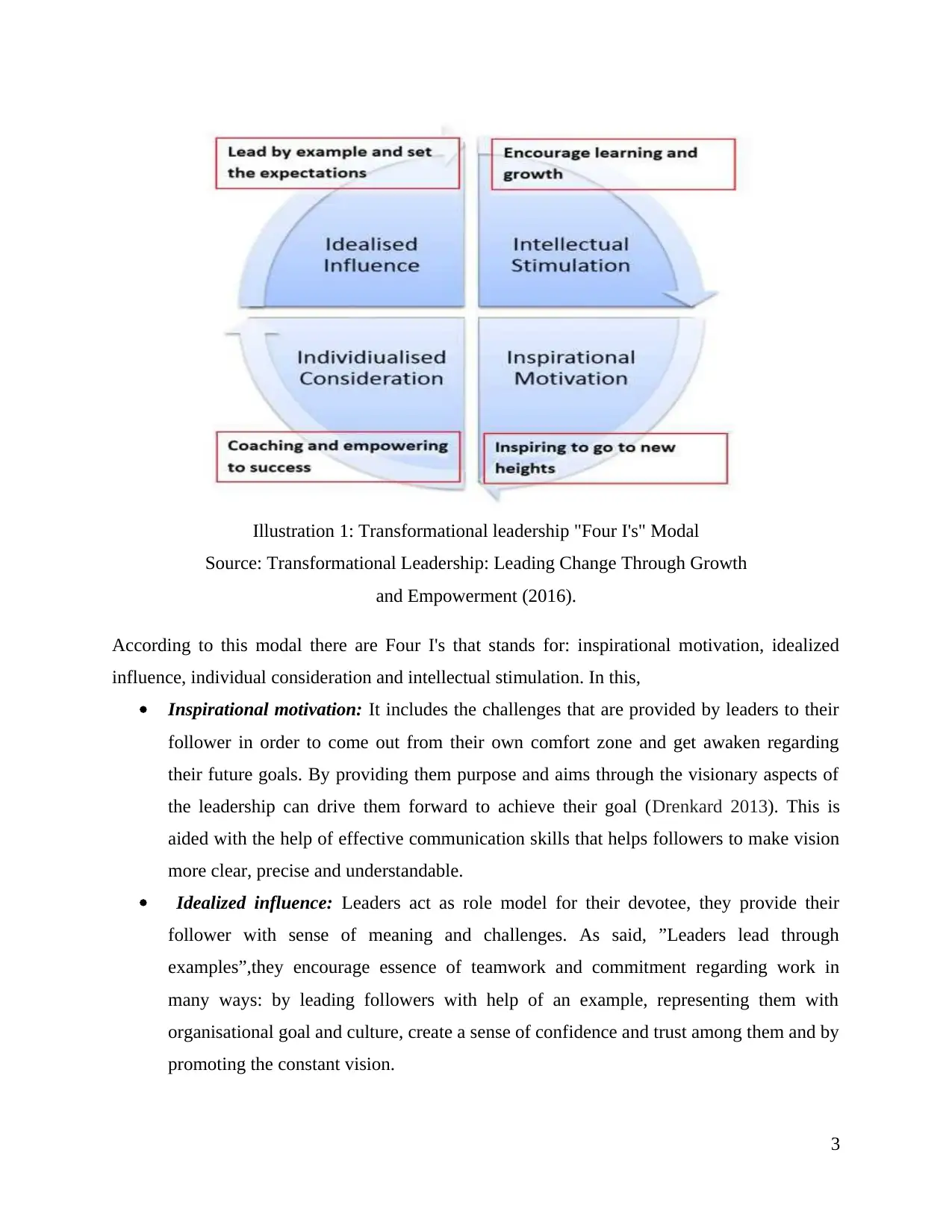
According to this modal there are Four I's that stands for: inspirational motivation, idealized
influence, individual consideration and intellectual stimulation. In this,
Inspirational motivation: It includes the challenges that are provided by leaders to their
follower in order to come out from their own comfort zone and get awaken regarding
their future goals. By providing them purpose and aims through the visionary aspects of
the leadership can drive them forward to achieve their goal (Drenkard 2013). This is
aided with the help of effective communication skills that helps followers to make vision
more clear, precise and understandable.
Idealized influence: Leaders act as role model for their devotee, they provide their
follower with sense of meaning and challenges. As said, ”Leaders lead through
examples”,they encourage essence of teamwork and commitment regarding work in
many ways: by leading followers with help of an example, representing them with
organisational goal and culture, create a sense of confidence and trust among them and by
promoting the constant vision.
3
Illustration 1: Transformational leadership "Four I's" Modal
Source: Transformational Leadership: Leading Change Through Growth
and Empowerment (2016).
influence, individual consideration and intellectual stimulation. In this,
Inspirational motivation: It includes the challenges that are provided by leaders to their
follower in order to come out from their own comfort zone and get awaken regarding
their future goals. By providing them purpose and aims through the visionary aspects of
the leadership can drive them forward to achieve their goal (Drenkard 2013). This is
aided with the help of effective communication skills that helps followers to make vision
more clear, precise and understandable.
Idealized influence: Leaders act as role model for their devotee, they provide their
follower with sense of meaning and challenges. As said, ”Leaders lead through
examples”,they encourage essence of teamwork and commitment regarding work in
many ways: by leading followers with help of an example, representing them with
organisational goal and culture, create a sense of confidence and trust among them and by
promoting the constant vision.
3
Illustration 1: Transformational leadership "Four I's" Modal
Source: Transformational Leadership: Leading Change Through Growth
and Empowerment (2016).
⊘ This is a preview!⊘
Do you want full access?
Subscribe today to unlock all pages.

Trusted by 1+ million students worldwide
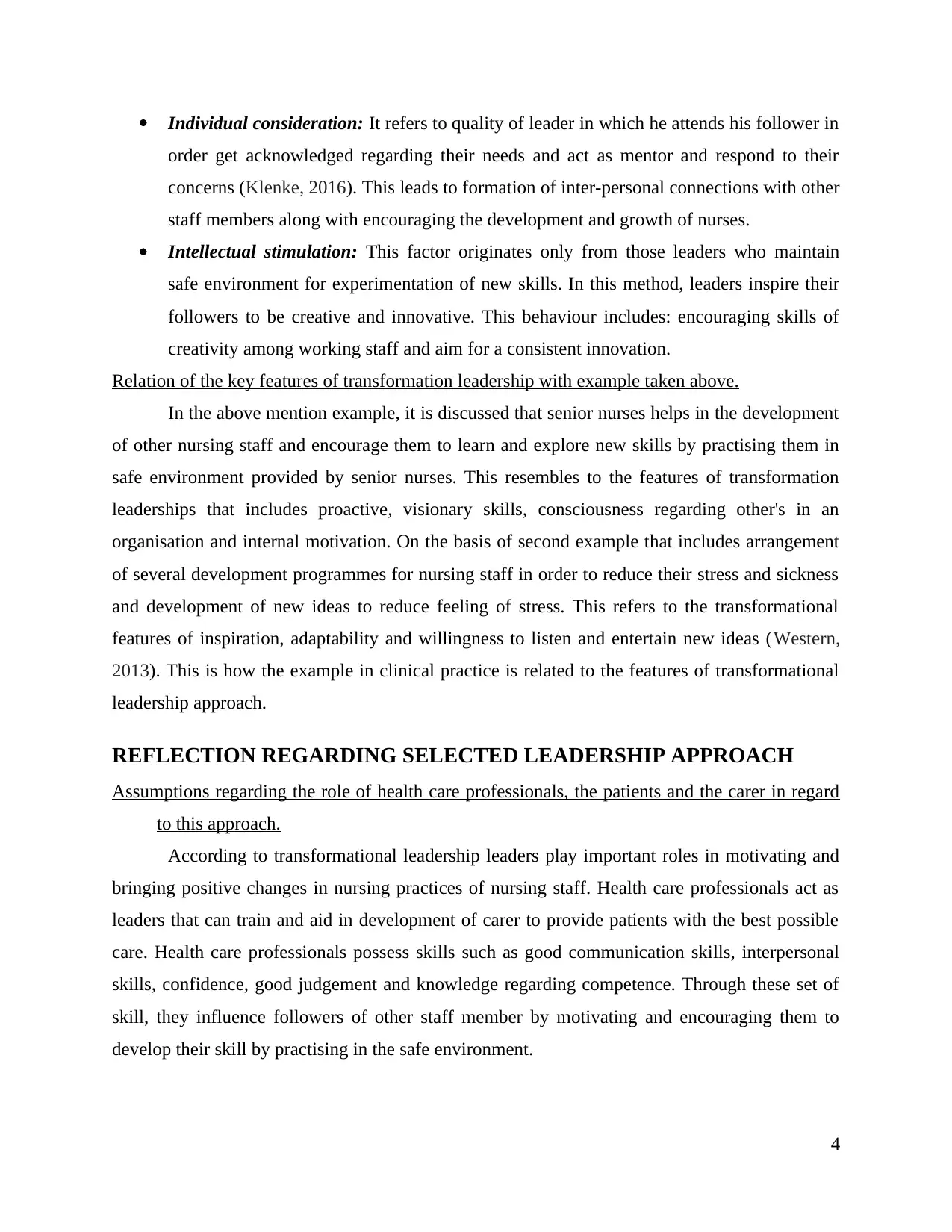
Individual consideration: It refers to quality of leader in which he attends his follower in
order get acknowledged regarding their needs and act as mentor and respond to their
concerns (Klenke, 2016). This leads to formation of inter-personal connections with other
staff members along with encouraging the development and growth of nurses.
Intellectual stimulation: This factor originates only from those leaders who maintain
safe environment for experimentation of new skills. In this method, leaders inspire their
followers to be creative and innovative. This behaviour includes: encouraging skills of
creativity among working staff and aim for a consistent innovation.
Relation of the key features of transformation leadership with example taken above.
In the above mention example, it is discussed that senior nurses helps in the development
of other nursing staff and encourage them to learn and explore new skills by practising them in
safe environment provided by senior nurses. This resembles to the features of transformation
leaderships that includes proactive, visionary skills, consciousness regarding other's in an
organisation and internal motivation. On the basis of second example that includes arrangement
of several development programmes for nursing staff in order to reduce their stress and sickness
and development of new ideas to reduce feeling of stress. This refers to the transformational
features of inspiration, adaptability and willingness to listen and entertain new ideas (Western,
2013). This is how the example in clinical practice is related to the features of transformational
leadership approach.
REFLECTION REGARDING SELECTED LEADERSHIP APPROACH
Assumptions regarding the role of health care professionals, the patients and the carer in regard
to this approach.
According to transformational leadership leaders play important roles in motivating and
bringing positive changes in nursing practices of nursing staff. Health care professionals act as
leaders that can train and aid in development of carer to provide patients with the best possible
care. Health care professionals possess skills such as good communication skills, interpersonal
skills, confidence, good judgement and knowledge regarding competence. Through these set of
skill, they influence followers of other staff member by motivating and encouraging them to
develop their skill by practising in the safe environment.
4
order get acknowledged regarding their needs and act as mentor and respond to their
concerns (Klenke, 2016). This leads to formation of inter-personal connections with other
staff members along with encouraging the development and growth of nurses.
Intellectual stimulation: This factor originates only from those leaders who maintain
safe environment for experimentation of new skills. In this method, leaders inspire their
followers to be creative and innovative. This behaviour includes: encouraging skills of
creativity among working staff and aim for a consistent innovation.
Relation of the key features of transformation leadership with example taken above.
In the above mention example, it is discussed that senior nurses helps in the development
of other nursing staff and encourage them to learn and explore new skills by practising them in
safe environment provided by senior nurses. This resembles to the features of transformation
leaderships that includes proactive, visionary skills, consciousness regarding other's in an
organisation and internal motivation. On the basis of second example that includes arrangement
of several development programmes for nursing staff in order to reduce their stress and sickness
and development of new ideas to reduce feeling of stress. This refers to the transformational
features of inspiration, adaptability and willingness to listen and entertain new ideas (Western,
2013). This is how the example in clinical practice is related to the features of transformational
leadership approach.
REFLECTION REGARDING SELECTED LEADERSHIP APPROACH
Assumptions regarding the role of health care professionals, the patients and the carer in regard
to this approach.
According to transformational leadership leaders play important roles in motivating and
bringing positive changes in nursing practices of nursing staff. Health care professionals act as
leaders that can train and aid in development of carer to provide patients with the best possible
care. Health care professionals possess skills such as good communication skills, interpersonal
skills, confidence, good judgement and knowledge regarding competence. Through these set of
skill, they influence followers of other staff member by motivating and encouraging them to
develop their skill by practising in the safe environment.
4
Paraphrase This Document
Need a fresh take? Get an instant paraphrase of this document with our AI Paraphraser
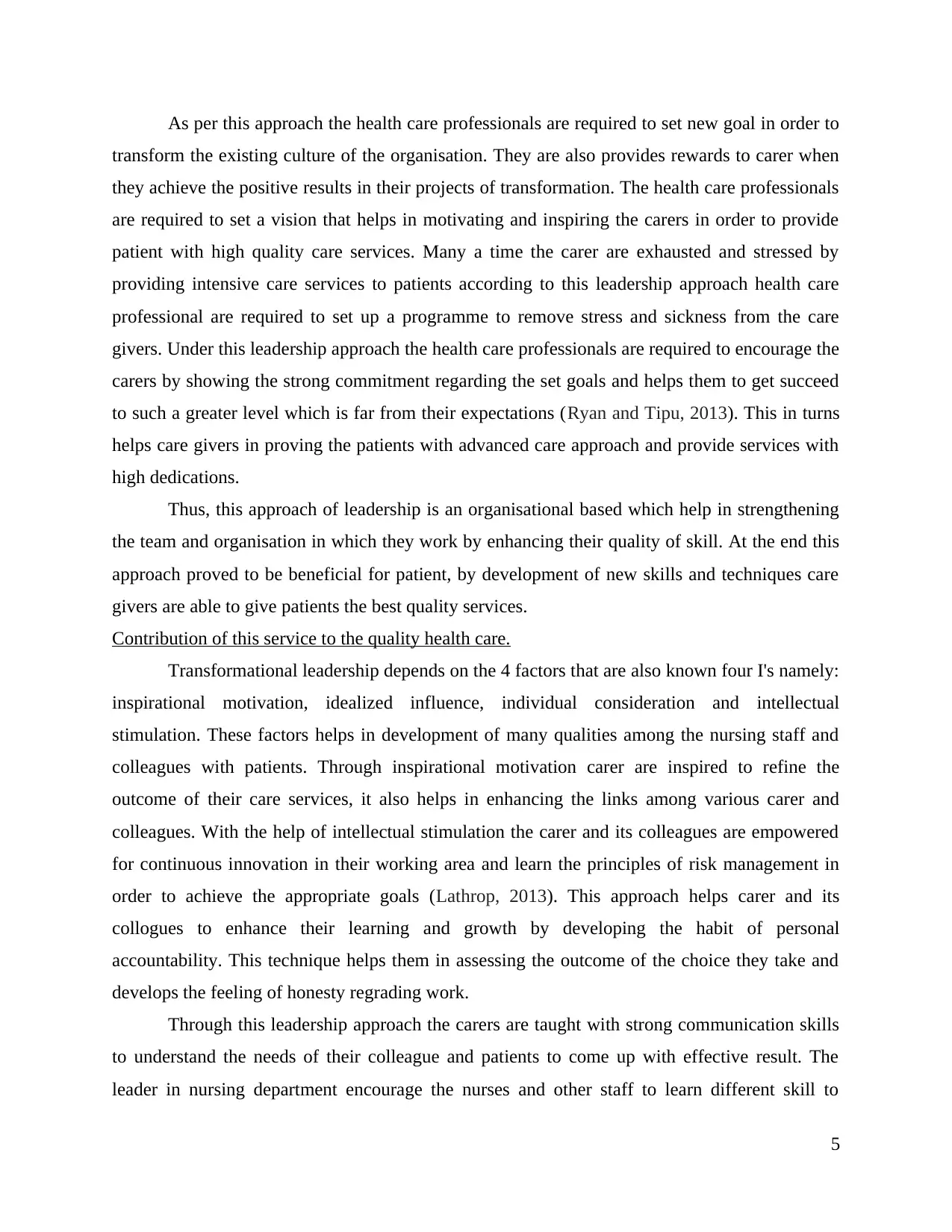
As per this approach the health care professionals are required to set new goal in order to
transform the existing culture of the organisation. They are also provides rewards to carer when
they achieve the positive results in their projects of transformation. The health care professionals
are required to set a vision that helps in motivating and inspiring the carers in order to provide
patient with high quality care services. Many a time the carer are exhausted and stressed by
providing intensive care services to patients according to this leadership approach health care
professional are required to set up a programme to remove stress and sickness from the care
givers. Under this leadership approach the health care professionals are required to encourage the
carers by showing the strong commitment regarding the set goals and helps them to get succeed
to such a greater level which is far from their expectations (Ryan and Tipu, 2013). This in turns
helps care givers in proving the patients with advanced care approach and provide services with
high dedications.
Thus, this approach of leadership is an organisational based which help in strengthening
the team and organisation in which they work by enhancing their quality of skill. At the end this
approach proved to be beneficial for patient, by development of new skills and techniques care
givers are able to give patients the best quality services.
Contribution of this service to the quality health care.
Transformational leadership depends on the 4 factors that are also known four I's namely:
inspirational motivation, idealized influence, individual consideration and intellectual
stimulation. These factors helps in development of many qualities among the nursing staff and
colleagues with patients. Through inspirational motivation carer are inspired to refine the
outcome of their care services, it also helps in enhancing the links among various carer and
colleagues. With the help of intellectual stimulation the carer and its colleagues are empowered
for continuous innovation in their working area and learn the principles of risk management in
order to achieve the appropriate goals (Lathrop, 2013). This approach helps carer and its
collogues to enhance their learning and growth by developing the habit of personal
accountability. This technique helps them in assessing the outcome of the choice they take and
develops the feeling of honesty regrading work.
Through this leadership approach the carers are taught with strong communication skills
to understand the needs of their colleague and patients to come up with effective result. The
leader in nursing department encourage the nurses and other staff to learn different skill to
5
transform the existing culture of the organisation. They are also provides rewards to carer when
they achieve the positive results in their projects of transformation. The health care professionals
are required to set a vision that helps in motivating and inspiring the carers in order to provide
patient with high quality care services. Many a time the carer are exhausted and stressed by
providing intensive care services to patients according to this leadership approach health care
professional are required to set up a programme to remove stress and sickness from the care
givers. Under this leadership approach the health care professionals are required to encourage the
carers by showing the strong commitment regarding the set goals and helps them to get succeed
to such a greater level which is far from their expectations (Ryan and Tipu, 2013). This in turns
helps care givers in proving the patients with advanced care approach and provide services with
high dedications.
Thus, this approach of leadership is an organisational based which help in strengthening
the team and organisation in which they work by enhancing their quality of skill. At the end this
approach proved to be beneficial for patient, by development of new skills and techniques care
givers are able to give patients the best quality services.
Contribution of this service to the quality health care.
Transformational leadership depends on the 4 factors that are also known four I's namely:
inspirational motivation, idealized influence, individual consideration and intellectual
stimulation. These factors helps in development of many qualities among the nursing staff and
colleagues with patients. Through inspirational motivation carer are inspired to refine the
outcome of their care services, it also helps in enhancing the links among various carer and
colleagues. With the help of intellectual stimulation the carer and its colleagues are empowered
for continuous innovation in their working area and learn the principles of risk management in
order to achieve the appropriate goals (Lathrop, 2013). This approach helps carer and its
collogues to enhance their learning and growth by developing the habit of personal
accountability. This technique helps them in assessing the outcome of the choice they take and
develops the feeling of honesty regrading work.
Through this leadership approach the carers are taught with strong communication skills
to understand the needs of their colleague and patients to come up with effective result. The
leader in nursing department encourage the nurses and other staff to learn different skill to
5
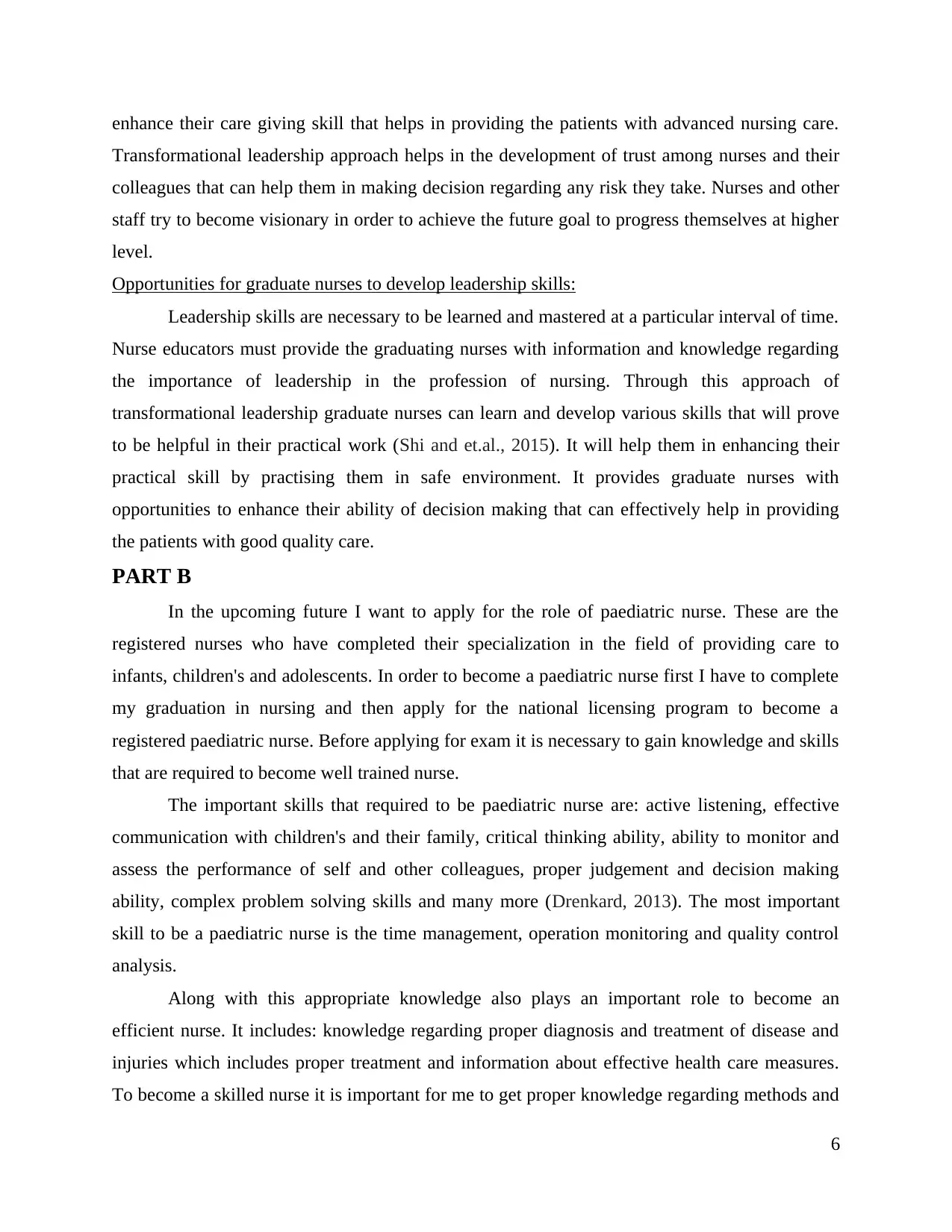
enhance their care giving skill that helps in providing the patients with advanced nursing care.
Transformational leadership approach helps in the development of trust among nurses and their
colleagues that can help them in making decision regarding any risk they take. Nurses and other
staff try to become visionary in order to achieve the future goal to progress themselves at higher
level.
Opportunities for graduate nurses to develop leadership skills:
Leadership skills are necessary to be learned and mastered at a particular interval of time.
Nurse educators must provide the graduating nurses with information and knowledge regarding
the importance of leadership in the profession of nursing. Through this approach of
transformational leadership graduate nurses can learn and develop various skills that will prove
to be helpful in their practical work (Shi and et.al., 2015). It will help them in enhancing their
practical skill by practising them in safe environment. It provides graduate nurses with
opportunities to enhance their ability of decision making that can effectively help in providing
the patients with good quality care.
PART B
In the upcoming future I want to apply for the role of paediatric nurse. These are the
registered nurses who have completed their specialization in the field of providing care to
infants, children's and adolescents. In order to become a paediatric nurse first I have to complete
my graduation in nursing and then apply for the national licensing program to become a
registered paediatric nurse. Before applying for exam it is necessary to gain knowledge and skills
that are required to become well trained nurse.
The important skills that required to be paediatric nurse are: active listening, effective
communication with children's and their family, critical thinking ability, ability to monitor and
assess the performance of self and other colleagues, proper judgement and decision making
ability, complex problem solving skills and many more (Drenkard, 2013). The most important
skill to be a paediatric nurse is the time management, operation monitoring and quality control
analysis.
Along with this appropriate knowledge also plays an important role to become an
efficient nurse. It includes: knowledge regarding proper diagnosis and treatment of disease and
injuries which includes proper treatment and information about effective health care measures.
To become a skilled nurse it is important for me to get proper knowledge regarding methods and
6
Transformational leadership approach helps in the development of trust among nurses and their
colleagues that can help them in making decision regarding any risk they take. Nurses and other
staff try to become visionary in order to achieve the future goal to progress themselves at higher
level.
Opportunities for graduate nurses to develop leadership skills:
Leadership skills are necessary to be learned and mastered at a particular interval of time.
Nurse educators must provide the graduating nurses with information and knowledge regarding
the importance of leadership in the profession of nursing. Through this approach of
transformational leadership graduate nurses can learn and develop various skills that will prove
to be helpful in their practical work (Shi and et.al., 2015). It will help them in enhancing their
practical skill by practising them in safe environment. It provides graduate nurses with
opportunities to enhance their ability of decision making that can effectively help in providing
the patients with good quality care.
PART B
In the upcoming future I want to apply for the role of paediatric nurse. These are the
registered nurses who have completed their specialization in the field of providing care to
infants, children's and adolescents. In order to become a paediatric nurse first I have to complete
my graduation in nursing and then apply for the national licensing program to become a
registered paediatric nurse. Before applying for exam it is necessary to gain knowledge and skills
that are required to become well trained nurse.
The important skills that required to be paediatric nurse are: active listening, effective
communication with children's and their family, critical thinking ability, ability to monitor and
assess the performance of self and other colleagues, proper judgement and decision making
ability, complex problem solving skills and many more (Drenkard, 2013). The most important
skill to be a paediatric nurse is the time management, operation monitoring and quality control
analysis.
Along with this appropriate knowledge also plays an important role to become an
efficient nurse. It includes: knowledge regarding proper diagnosis and treatment of disease and
injuries which includes proper treatment and information about effective health care measures.
To become a skilled nurse it is important for me to get proper knowledge regarding methods and
6
⊘ This is a preview!⊘
Do you want full access?
Subscribe today to unlock all pages.

Trusted by 1+ million students worldwide

procedures of various therapies that help in the rehabilitation of the mental dysfunction. Along
with this knowledge paediatric nurses should also posses command over public safety and
security aspects which involves the policies, procedures and rules and regulations that promote
security of patients and their medical data (Malik, 2013).
Nurses should also have understanding regarding psychological aspects of children's.
This includes the knowledge regarding behaviours of infants and children's and their
performance. To become a paediatric nurse in upcoming 12 to 24 months I have to first clear h
examination to become a registered nurse. Now for getting specific knowledge and
understanding regarding the anatomy, child physiology and information related to diseases I can
join the certification course of 6-10 months called that can further help in enhancing my
knowledge and experience in aspects of paediatric nursing. After obtaining this certificate from
Paediatric Nursing Certification Board I can work with professional working in paediatric
centres in order to gain experience and learning to become a paediatric nurse. Thus, through this
I can set up myself in future as a professional paediatric nurse.
7
with this knowledge paediatric nurses should also posses command over public safety and
security aspects which involves the policies, procedures and rules and regulations that promote
security of patients and their medical data (Malik, 2013).
Nurses should also have understanding regarding psychological aspects of children's.
This includes the knowledge regarding behaviours of infants and children's and their
performance. To become a paediatric nurse in upcoming 12 to 24 months I have to first clear h
examination to become a registered nurse. Now for getting specific knowledge and
understanding regarding the anatomy, child physiology and information related to diseases I can
join the certification course of 6-10 months called that can further help in enhancing my
knowledge and experience in aspects of paediatric nursing. After obtaining this certificate from
Paediatric Nursing Certification Board I can work with professional working in paediatric
centres in order to gain experience and learning to become a paediatric nurse. Thus, through this
I can set up myself in future as a professional paediatric nurse.
7
Paraphrase This Document
Need a fresh take? Get an instant paraphrase of this document with our AI Paraphraser

REFERENCES
Books and journals
Drenkard, K., 2013. Transformational leadership: unleashing the potential. Journal of Nursing
Administration. 43(2). pp.57-58.
Klenke, K. ed., 2016. Qualitative research in the study of leadership. Emerald Group Publishing
Limited.
Lathrop, B., 2013. Nursing leadership in addressing the social determinants of health. Policy,
Politics, & Nursing Practice. 14(1). pp.41-47.
Malik, S. H., 2013. Relationship between Leader Behaviors and Employees' Job Satisfaction: A
Path-Goal Approach. Pakistan Journal of Commerce & Social Sciences, 7(1).
Omar, W. W., 2013. Transformational leadership style and job satisfaction relationship: A study
of structural equation modeling (SEM). International journal of academic research in
business and social sciences. 3(2). p.346.
Parris, D. L. and Peachey, J. W., 2013. A systematic literature review of servant leadership
theory in organizational contexts. Journal of business ethics. 113(3). pp.377-393.
Romano, J., Trotta, R. and Rich, V. L., 2013. Combating compassion fatigue: An exemplar of an
approach to nursing renewal. Nursing administration quarterly. 37(4). pp.333-336.
Ryan, J. C. and Tipu, S. A., 2013. Leadership effects on innovation propensity: A two-factor full
range leadership model. Journal of Business Research. 66(10). pp.2116-2129.
Shi, R. and et.al., 2015. Regulatory focus and burnout in nurses: The mediating effect of
perception of transformational leadership. International journal of nursing
practice. 21(6). pp.858-867.
Tillott, S., Walsh, K. and Moxham, L., 2013. Encouraging engagement at work to improve
retention: Sarah Tillott and colleagues explore how a social interaction tool can help
managers recruit and retain staff, and boost patient care. Nursing Management. 19(10).
pp.27-31.
Western, S., 2013. Leadership: A critical text. Sage.
Online
Transformational Leadership: Leading Change Through Growth and Empowerment. 2016.
[Online]. Avalable through
8
Books and journals
Drenkard, K., 2013. Transformational leadership: unleashing the potential. Journal of Nursing
Administration. 43(2). pp.57-58.
Klenke, K. ed., 2016. Qualitative research in the study of leadership. Emerald Group Publishing
Limited.
Lathrop, B., 2013. Nursing leadership in addressing the social determinants of health. Policy,
Politics, & Nursing Practice. 14(1). pp.41-47.
Malik, S. H., 2013. Relationship between Leader Behaviors and Employees' Job Satisfaction: A
Path-Goal Approach. Pakistan Journal of Commerce & Social Sciences, 7(1).
Omar, W. W., 2013. Transformational leadership style and job satisfaction relationship: A study
of structural equation modeling (SEM). International journal of academic research in
business and social sciences. 3(2). p.346.
Parris, D. L. and Peachey, J. W., 2013. A systematic literature review of servant leadership
theory in organizational contexts. Journal of business ethics. 113(3). pp.377-393.
Romano, J., Trotta, R. and Rich, V. L., 2013. Combating compassion fatigue: An exemplar of an
approach to nursing renewal. Nursing administration quarterly. 37(4). pp.333-336.
Ryan, J. C. and Tipu, S. A., 2013. Leadership effects on innovation propensity: A two-factor full
range leadership model. Journal of Business Research. 66(10). pp.2116-2129.
Shi, R. and et.al., 2015. Regulatory focus and burnout in nurses: The mediating effect of
perception of transformational leadership. International journal of nursing
practice. 21(6). pp.858-867.
Tillott, S., Walsh, K. and Moxham, L., 2013. Encouraging engagement at work to improve
retention: Sarah Tillott and colleagues explore how a social interaction tool can help
managers recruit and retain staff, and boost patient care. Nursing Management. 19(10).
pp.27-31.
Western, S., 2013. Leadership: A critical text. Sage.
Online
Transformational Leadership: Leading Change Through Growth and Empowerment. 2016.
[Online]. Avalable through
8

<http://www.educational-business-articles.com/transformational-leadership/>. [Accessed
on 3rd October 2017].
9
on 3rd October 2017].
9
⊘ This is a preview!⊘
Do you want full access?
Subscribe today to unlock all pages.

Trusted by 1+ million students worldwide
1 out of 12
Related Documents
Your All-in-One AI-Powered Toolkit for Academic Success.
+13062052269
info@desklib.com
Available 24*7 on WhatsApp / Email
![[object Object]](/_next/static/media/star-bottom.7253800d.svg)
Unlock your academic potential
Copyright © 2020–2025 A2Z Services. All Rights Reserved. Developed and managed by ZUCOL.





